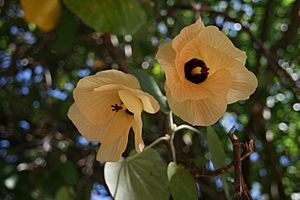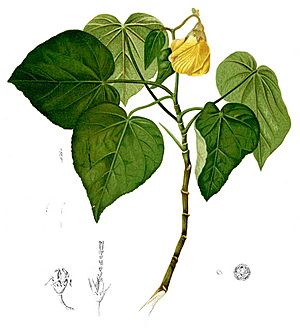Sea hibiscus facts for kids
Quick facts for kids Sea hibiscus |
|
|---|---|
 |
|
| Sea hibiscus from Tahiti | |
 |
|
| Sea hibiscus from Flora de Filipinas (Francisco Manuel Blanco, 1880-1883) | |
| Conservation status | |
| Scientific classification | |
| Genus: |
Hibiscus
|
| Species: |
tiliaceus
|
| Synonyms | |
|
Talipariti tiliaceum (L.) Fryxell |
|
The Hibiscus tiliaceus is a type of flowering tree. It belongs to the mallow family, called Malvaceae. This tree naturally grows in the warm, tropical parts of the Old World (like Asia, Africa, and Australia).
People call it by many names, such as sea hibiscus, beach hibiscus, or coastal hibiscus. Other names include coastal cottonwood and native hibiscus. In different languages, it's known as balibago (Tagalog), waru (Javanese), hau (Hawaiian), and purau (Tahitian). The name "tiliaceus" means its leaves look like those of the Tilia tree, which is also a type of tree.
Contents
What Does the Sea Hibiscus Look Like?
The sea hibiscus tree can grow quite tall, usually between 4 to 10 meters (about 13 to 33 feet). Its trunk can be up to 15 centimeters (about 6 inches) wide.
Its Amazing Flowers
The flowers of the sea hibiscus are very special. When they first open, they are bright yellow with a deep red center. As the day goes on, their color changes! They turn orange and then finally become red before they fall off the tree. The branches of this tree often bend and curve over time, giving it a unique shape. Its leaves are shaped like a heart. Some types, called 'var. rubra', have deep red leaves.
Where Does the Sea Hibiscus Grow?
The sea hibiscus is a common plant found along the coasts of many places. You can see it in Eastern and Northern Australia, across Oceania, in the Maldives, South Asia, and Southeast Asia.
Its Home and Spread
This tree has also started growing naturally in new places, like Florida, Puerto Rico, and the Virgin Islands. It's not clear if it was always in Hawaii, or if people from Polynesia brought it there a long time ago.
The sea hibiscus likes to grow from sea level up to 800 meters (about 2,600 feet) high. It needs areas that get a good amount of rain each year. You can often find it on beaches, next to rivers, and in mangrove swamps.
Tough Coastal Plant
This plant is very good at living by the sea. It can handle salty conditions and areas where the ground is often wet. It can grow in different types of sand, limestone, and even crushed basalt rock. It grows best in soils that are slightly acidic to alkaline (with a pH of 5 to 8.5). In Australia, a place called Cotton Tree, Queensland is named after this plant.
How People Use the Sea Hibiscus

The wood of the sea hibiscus is quite strong. People have used it for many things.
Wood and Fibers
- It's used to build seacraft (like boats).
- It makes good firewood.
- People use it for wood carvings.
- It's easy to work with, so it's also used to make high-quality furniture.
The plant's stems have strong fibers. These fibers have traditionally been used to make rope. The bark of the tree can be used like cork to seal cracks in boats.
Food and Medicine
- The bark and roots can be boiled to make a cooling tea. This tea helps to cool down fevers.
- The young, leafy shoots of the plant can be eaten as vegetables.
Traditional Uses
Native Hawaiians used the wood of the sea hibiscus for their waʻa (outrigger canoes). They made ʻiako (spars, which are poles that support the sails) and mouo (floats for fishing nets). They also made ʻau koʻi (handles for adzes, a type of tool). Strong cords called Kaula ʻilihau were made from the plant's inner bark fibers. If they couldn't find wiliwili wood, they would use hau (sea hibiscus) to make ʻama (canoe floats).
Other Interesting Uses
- In Asian countries, the sea hibiscus is very popular for the art of bonsai. Bonsai is the art of growing miniature trees in pots. The best bonsai specimens often come from Kenting National Park in Taiwan.
- Its leaves are also used in cooking. They can serve as trays for steaming rice cakes, like 粿.
- In Indonesia, the leaves of H. tiliaceus are used to help make tempeh. Tempeh is a food made from fermented soybeans. The underside of the leaves has tiny hairs where a special mold, Rhizopus oligosporus, can be found. Soybeans are pressed onto the leaf, and the mold helps them ferment into tempeh.
Images for kids
-
var pernambucensis in Brazil
See also
 In Spanish: Hibiscus tiliaceus para niños
In Spanish: Hibiscus tiliaceus para niños



